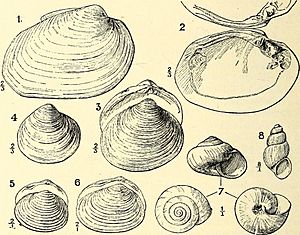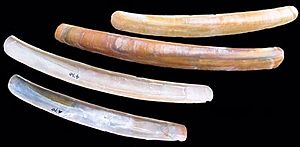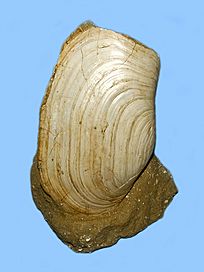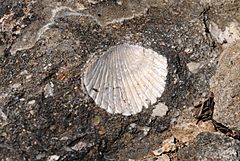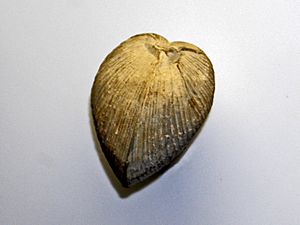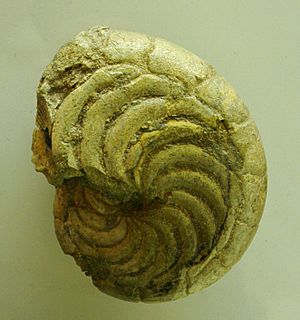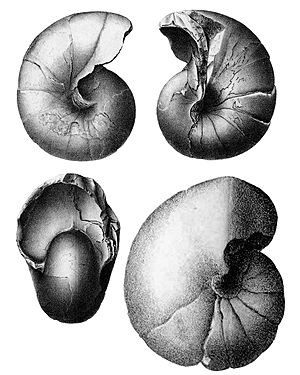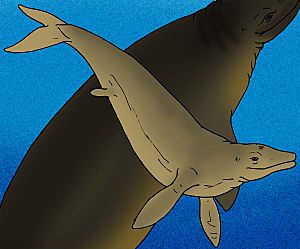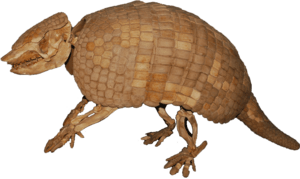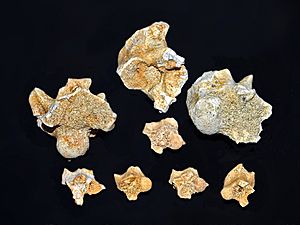Castle Hayne Limestone facts for kids
Quick facts for kids Castle Hayne LimestoneStratigraphic range: Eocene |
|
|---|---|
| Type | Formation |
| Sub-units | New Hanover Member, Comfort Member, Spring Garden Member |
| Lithology | |
| Primary | limestone |
| Other | marl |
| Location | |
| Region | |
| Country | |
| Type section | |
| Named for | Castle Hayne, North Carolina |
The Castle Hayne Limestone (also called the Castle Hayne Formation) is a special rock layer found in North Carolina. It is made of rounded pieces of rock, like small pebbles or cobbles. These pieces are often covered with minerals like phosphate and glauconite. All of this is held together in a limestone "glue."
Scientists love the Castle Hayne Limestone because it holds many fossils. These fossils are from the Paleogene period, specifically the Eocene epoch. This means they are millions of years old! The formation is named after Castle Hayne, North Carolina, a town in New Hanover County, North Carolina. However, the rock layer itself stretches across several counties.
What is the Castle Hayne Limestone?
The Castle Hayne Formation is split into three main parts, like layers in a cake. Scientists call these parts "members." They are the New Hanover Member, the Comfort Member, and the Spring Garden Member. Each member has slightly different features and fossils.
New Hanover Member
The New Hanover Member is the oldest part of the formation. It has small rocks like cobbles and pebbles, along with fine sand. You can also find minerals like glauconite and phosphate here. These are all stuck together in a fine limestone. The most common fossils found in this layer are teeth from ancient sharks and rays. Special fossils, called index fossils, tell us this member formed during the middle Eocene.
Comfort Member
Above the New Hanover Member is the Comfort Member. This layer contains fossils of tiny sea animals called bryozoa and sea urchins. It also has layers of glauconite and phosphate pebbles. These pebble layers show times when new sediments stopped being laid down. The Comfort Member was also formed in the late middle Eocene.
Spring Garden Member
The Spring Garden Member sits on top of the Comfort Member. This part of the rock is a silica-rich rock (meaning it has a lot of silica, like sand). It is cemented together with calcite, a common mineral. This member also contains small pieces of phosphate. In some areas, up to 75% of this layer is made of mollusc shells. You can often find molds of mollusc shells that have been filled with silica. Index fossils show that this member also formed during the late middle Eocene.
Amazing Fossils of Castle Hayne
The Castle Hayne Limestone is famous for its incredible fossils. These ancient remains help us learn about the plants and animals that lived millions of years ago in North Carolina.
Invertebrate Fossils
Invertebrates are animals without backbones, like clams, snails, and crabs. The Castle Hayne Limestone has many different types of fossil invertebrates.
Ancient Molluscs
Molluscs are a large group of soft-bodied animals. They often have hard shells, like clams, oysters, and snails.
| Genera | Notes | Images |
|---|---|---|
| Chione | A type of clam. | |
| Ensis | Looks like a modern razor clam. | |
| Panopea | A relative of the modern geoduck, a very large clam. | |
| Pecten | An extinct scallop, similar to the ones we eat today. | |
| Pholadomya | A type of clam. |
Ancient Cephalopods
Cephalopods are a group of molluscs that include squids, octopuses, and cuttlefish.
| Genera | Notes | Images |
|---|---|---|
| Anomalosaepia | An extinct type of cuttlefish. | |
| Aturia | A unique ancient nautiloid (a type of cephalopod with an external shell). | |
| Eutrephoceras | Another type of ancient nautiloid. | E. dorbignyanum, a related species. |
Vertebrate Fossils
Vertebrates are animals with backbones, like fish, reptiles, birds, and mammals. The Castle Hayne Limestone has some exciting vertebrate fossils!
Ancient Mammals
Mammals are warm-blooded animals that usually have fur or hair.
Ancient Whales (Cetaceans)
| Genus | Notes | Images |
|---|---|---|
| Zygorhiza | An early type of whale, related to the well-known Dorudon. |
Ancient Manatees (Sirenians)
| Genus | Notes | Images |
|---|---|---|
| Protosiren | A prehistoric relative of modern manatees and dugongs. |
Giant Armadillos (Cingulates)
| Genus | Notes | Images |
|---|---|---|
| Holmesina | A giant armadillo-like animal called a pampathere. It migrated to North America from South America. |
Ancient Reptiles
Reptiles are cold-blooded animals, like snakes, lizards, and crocodiles.
Ancient Snakes (Squamates)
| Genus | Notes | Images |
|---|---|---|
| Palaeophis | An extinct species of giant marine snake. |
Ancient Turtles
| Genus | Notes | Images |
|---|---|---|
| Cheloniidae indet | Known from pieces of their shells. |
Ancient Crocodilians
| Genus | Notes | Images |
|---|---|---|
| Crocodylia indet | Known from pieces of their backbones (vertebra). |


